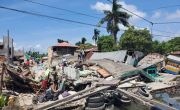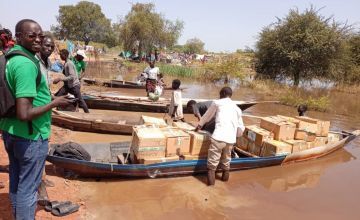
Knowledge Hub
What is a humanitarian crisis?

Generally, a humanitarian crisis is defined as an event or series of events that represents a critical threat to the health, safety, security or wellbeing of a community or other large group of people, usually over a wide area. There is no universal definition of a humanitarian crisis, and the terms ‘humanitarian crises’ and ‘humanitarian emergency’ are often used interchangeably.
Types of humanitarian crises
There are three different types of humanitarian crises:
- natural disasters
- man-made emergencies
- complex emergencies.
Natural disasters



Natural disasters are disasters that occur as a result of activity within the natural processes of the earth. Examples of natural disasters include:
- Geophysical disasters such as earthquakes, tsunamis and volcanic eruptions;
- Hydrological disasters such as floods and avalanches;
- Climatological disasters such as droughts;
- Meteorological disasters such as storms and cyclones;
- And biological disasters such as epidemics, plagues and infestations.
On average, natural disasters kill around 60,000 people a year, globally. According to Our World in Data, the number of deaths from natural disasters can vary significantly from year-to-year; some years pass with very few deaths before a large disaster event claims many lives. Looking at the average over the past decade, approximately 60,000 people globally died from natural disasters each year. This represents 0.1% of annual global deaths.
Moreover, you cannot capture the full human impact of natural disasters by looking solely at mortality rates. Injury, homelessness, and displacement all have a significant impact.
Man-made emergencies

Man-made emergencies are extremely dangerous events that are caused by human beings. Such emergencies include:
- Conflict
- Environmental degradation
- Pollution
- Fires
- Plane and train crashes
- Industrial accidents
- Weapons of mass destruction
For example, the blast that struck Beirut in August 2020 was a man-made emergency. In fact, it was one of the largest non-nuclear explosions in history. The disaster resulted from a fire, which caused the explosion of tonnes of ammonium nitrate, a combustible chemical compound commonly used in agriculture as a high nitrate fertiliser, but which can also be used to manufacture explosives [Human Rights Watch]. The blast killed 218 people and displaced over 300,000 people.

Complex emergencies
Complex emergencies result from a combination of man-made and natural disasters. The United Nations (UN) defines a complex humanitarian emergency as “a humanitarian crisis in a country, region, or society where there is total or considerable breakdown of authority resulting from internal or external conflict and which requires an international response that goes beyond the mandate or capacity of any single and/or ongoing UN country programme.”
In short, complex humanitarian emergencies involve an acute emergency layered over ongoing instability.
Complex emergencies generally include:
- Extensive violence and loss of life
- Displacement of populations
- Widespread damage to societies and economies
- The need for large-scale humanitarian assistance
- The hindrance or prevention of humanitarian assistance by political and military constraints
- Significant security risks for humanitarian relief workers in some areas
The number and scale of these complex emergencies has surged in the past decade with the rise and intensification of conflicts.
Since the start of the Syrian war, an example of a complex emergency, more than 25.6 million people have fled their homes. Around 6.7 million are internally displaced, many of them living in camps, while another 5.6 million are registered as refugees abroad. Neighbouring Lebanon, Jordan and Turkey are hosting 93% of refugees and are struggling to cope with one of the largest refugee exoduses in recent history.

Lebanon has become the country with the highest concentration of refugees anywhere in the world, hosting approximately 1.5 million Syrian refugees. Syrians are competing with already vulnerable Lebanese people for affordable housing and services. Up to 70% lack valid residence permits, forcing families to make difficult decisions to survive. Many are falling deeper into debt and have been forced to move into sub-standard housing such as garages, dilapidated buildings, and tents.
The situation in Lebanon has deteriorated rapidly in the last year since the blast. Syrian refugees are still in need, but this is now compounded by the needs of Lebanese people affected and migrant workers, pushing the country even further into a complex state of emergency.
Who do humanitarian crises impact the most?
Globally, humanitarian crises affect more people today than at any point in recorded history. These crises have huge immediate and long-term impacts on hundreds of millions of people, particularly those already living in extreme poverty.
For example, those in lower-income countries are often the most vulnerable to natural disasters; their homes are less able to withstand shocks, and their livelihoods may be destroyed, with nothing to fall back on to support themselves or their families. Improving living standards, infrastructure and response systems in these regions is key to lessening the impact severity of natural disasters.
It is not easy to categorise a humanitarian disaster. However, the priority in any response is to save lives and minimise suffering through meeting basic needs. How such needs are met depends on the specific emergency.
What are the effects of humanitarian crises?
The effects of humanitarian crises are extremely damaging to affected communities, both in the short and longer-term. Such impacts are:
- Socio-economic downfalls
- Environmental and ecological damage
- Mental and physical health impacts
What can we do to help?

At Concern, we deliver humanitarian assistance to some of the world's poorest and most vulnerable people. In an emergency, we act quickly to save lives. Yet once the immediate crisis has passed, we remain on the ground helping to rebuild livelihoods and infrastructure so that communities are better prepared for future crises.
For example, In Lebanon, Concern’s immediate response to the Beirut explosion consisted of the rehabilitation of buildings and small businesses affected by the blast, and the provision of psychosocial support. Since then, the response has evolved to address the livelihoods, shelter and protection needs of vulnerable groups, namely migrants made homeless as a result of the blast.
For example, several consecutive years of drought in southern Ethiopia have led to low levels of food production, affecting access to food and disrupting the livelihoods of hundreds of thousands of farmers and herders. By June 2020, 8.5 million people required emergency food assistance. Our emergency nutrition response programmes reached over 253,000 of the most vulnerable people last year.
Find out more about our emergency response
Other ways to help
Donate now
Give a one-off, or a monthly, donation today.
Join an event
From mountain trekking to marathon running, join us for one of our many exciting outdoor events!
Buy a gift
With an extensive range of alternative gifts, we have something to suit everybody.
Leave a gift in your will
Leave the world a better place with a life-changing legacy.
Become a corporate supporter
We partner with a range of organisations that share our passion and the results have been fantastic.
Create your own fundraising event
Raise money for Concern by organising your own charity fundraising event.





